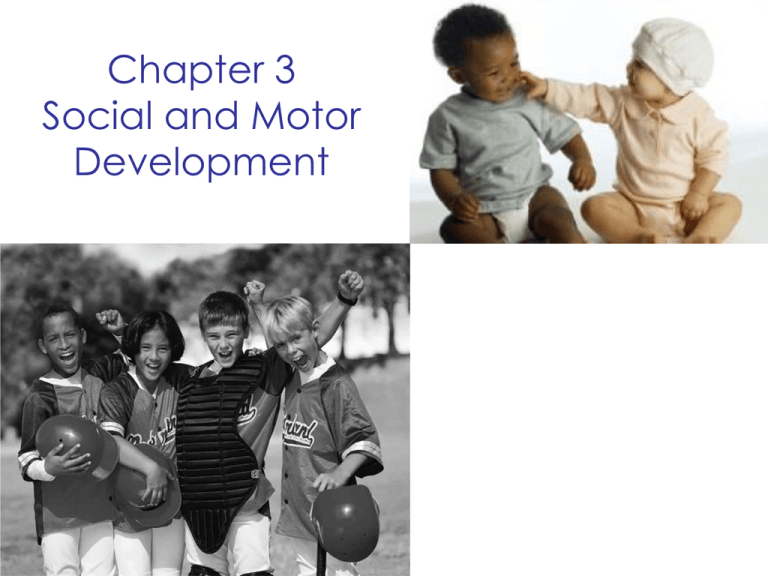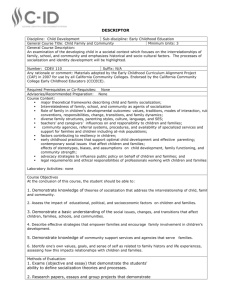
Chapter 3
Social and Motor
Development
Domains of Human Development
Social behavior affects
a person’s movement behavior,
and conversely, there are
equally strong effects
on an individual’s social
development.
Objectives
• Discuss socialization.
• Explain self-esteem, self-concept, and self-worth,
and their relationship to physical activity and
motor development.
• Describe the main social influences during
–
–
–
–
Infancy
Childhood
Adolescence
Adulthood
• Discuss the exercise-aging cycle.
Socialization
• A duel process of interaction and
development through which humans learn
– Who they are.
– How they are connected to the social worlds
in which they live.
– The orientations used as a basis for social
behavior and group life.
Socialization
• Socialization teaches members of a
society their social role.
• Social Roles ~ expected behaviors by
social groups in particular situations.
– E.g. Occupational roles
– E.g. Family roles
Socialization
• Societal Norms ~ set of expectations
by society.
• Societal norms can facilitate or impede
an individual’s movement development.
– E.g. Adolescent males should be athletic
– E.g. Older adults don’t exercise,
Terms of “Self”
• Self-esteem ~ how much we believe
ourselves to be competent, successful,
significant, and worthy
• Self-concept ~ perception of self
• Self-worth ~ overall value that one places
on oneself as a person
Terms of “Self”
• Involvement in directed play or physical
education can enhance self-esteem, selfconcept, and self-worth in children.
• Increases are greatest in emotionally
disturbed, mentally retarded, disabled,
and economically disadvantaged children.
Self-worth Evolves Developmentally
Early
Childhood
Mid-late
Childhood
• Cannot make meaningful judgments about selfworth.
• Have difficulty discerning between cognitive,
physical, and social competence.
• Begin to make meaningful judgments about
self-worth.
• Better able to distinguish between constructs of
scholastic competence, athletic competence,
peer social acceptance, physical appearance,
and behavioral conduct.
• Physical appearance and social acceptance
are most important constructs of global selfworth.
Harter, 1988
Self-worth Evolves Developmentally
Adolescence • Additional constructs emerge: friendship,
romantic appeal, job competence.
• Additional major contributors to global self-worth:
Parent, friend, classmate, and teacher support.
College Age
• Global self-worth becomes a function of
perceived self-worth in areas most important to
the individual.
• Additional constructs emerge: intellectual ability,
creativity, close friendships, relationships, sense
of humor, morality.
• Additional major contributors to global self-worth:
Intimate relationships, adequacy as a provider.
Adulthood
• Additional major contributors to global self-worth:
Nurturance, house-hold management.
Harter, 1988
Social Influences ~ Infancy
• Egocentric and asocial period
– Total reliance on caregivers
• Social ties that form in infancy
– Contact with an object of attachment
• Visual exchange with caregiver
• Reciprocal touch with caregiver
– Distress when object of attachment leaves
Social Influences ~ Infancy
• Newly developing movement activities
facilitate and expand social interactions
– E.g. Infant becomes more actively involved in
the environment.
Social Influences ~ Infancy
FOUR STAGES OF SOCIAL
ATTACHMENT
• Stage 1
– 0-3 months
– Grasps, sucks, roots, demonstrates reflexes,
visually tracks, gazes, cries, smiles
• Stage 2
– 4-6 months
– Distinguishes between strangers and familiar
figures
Social Influences ~ Infancy
FOUR STAGES OF SOCIAL
ATTACHMENT
• Stage 3
– 7 months – 2 years
– Locomotion
– Seeks close physical proximity with objects
of attachment
• Stage 4
– Controlled use of arms and hands in order to
respond to or pursue human touch
Social Influences ~ Childhood
• Play
– Major socializing force
• Family
– Primary socializing agent
– Preschool, TV, and babysitters
have lessened the impact of
family
Social Influence ~ Childhood
PLAY
• “An activity that is always pleasurable and
always cherished by the child, adolescent,
or adult.”
– Unproductive, spontaneous, and voluntary
– Motivation to play is intrinsic
– Involves active participation by the player
• Crucial part of leaning the rules of society /
functioning in society.
Garvey, 1990
Social Influence ~ Childhood
PLAY - TOYS
• 2003 Clinical Report of the American
Academy of Pediatrics
– Play is essential to learning.
– Toys should be carefully selected because they
are instrumental in child’s development.
– Toys can provide opportunity for social
interaction.
– Toys should not replace human love, caring,
and interaction.
Social Influence ~ Childhood
PLAY - RESEARCH
• Purpose
– To examine effects of play on child development.
• Method
– 30 orphans in India ages 2-5
– 3 month structured daily play program
• Results
– Increased motor, mental, physical, and social maturity
– E.g. More active, playful, and independent
• Conclusion
– Daily play sessions can positively affect child
development.
Taneja et al., 2002
Social Influence ~ Childhood
PLAY - RESEARCH
• Purpose
– Examine training and psychosocial factors throughout
development that may influence sport dropout.
• Method
– 25 dropout and 25 engaged (matched) adolescent
competitive swimmers completed structured interview.
• Results
– Dropouts were involved in significantly less unstructured
play swimming during childhood than engaged athletes.
• Conclusion
– Early unstructured play experiences may lead to more
intrinsic motivation for sport later in life.
Fraser-Thomas et al., 2008
Right to Play - www.righttoplay.com
• Right To Play is an international humanitarian organization
that uses sport and play programs to improve health,
develop life skills, and foster peace for children and
communities in some of the most disadvantaged areas of
the world.
• Right To Play is supported by an international team of top
athletes from over 40 countries. As role models, these
athletes inspire children, raise awareness and promote
opportunities for funding for Right To Play projects.
• Right To Play is headquartered in Toronto, Canada.
• Right To Play builds local capacity in four strategic areas:
–
–
–
–
Basic Education and Child Development
Health Promotion and Disease Prevention
Conflict Resolution and Peace Education
Community Development
Social Influence ~ Childhood
• SOLITARY PLAY
– 2 to 2½ years
– Child is more interested in his/her own activity.
– Children playing side by side will pay little attention to
each other.
Social Influence ~ Childhood
• PARALLEL PLAY
–
–
–
–
2½ to 3 ½ years
Still play by self.
More aware of other children around them.
May subtly copy each other’s play behavior.
Social Influence ~ Childhood
• ASSOCIATIVE PLAY
– 3 ½ to 4 ½ years
– Begin to exchange toys.
– No group goal.
• COOPERATIVE PLAY
– 4 ½ to 5 years
– Purposeful, group-oriented
play
– Group games and leaders
– Leadership, competition,
cooperation
Social Influences ~ Childhood
FAMILY
• Earliest and greatest determinant of
children’s movement choices
Social Influences ~ Childhood
FAMILY - PHYSICAL ACTIVITY RESEARCH
• Purpose: Examine social factors affecting children’s
PA
• Participants: 100 families of 5/6 graders
• Results: Factors affecting PA differed by gender
– Girls: PA knowledge, mother’s PA, social support
– Boys: PA self-efficacy, PA enjoyment, sport media interest
• Conclusion: Socialization in the family provides
“tremendous influence” on participation on PA.
DiLorenzo et al., 1998
Social Influences ~ Childhood
FAMILY – GIRLS’ PHYSICAL ACTIVITY RESEARCH
• Purpose: Effects of parenting practices on girls’ PA
• Participants: 200 9-year old girls and their parents
• Results:
– Mothers provide logistic support (e.g. enroll in programs).
– Fathers provide explicit modeling (e.g. model through their
own involvement).
– Girls with even 1 supportive parent showed higher PA
levels.
• Conclusion: Any amount of support from either
parent can have positive effects on girls’ PA levels.
Davison et al., 2003
Social Influence ~ Childhood
FAMILY – SPORT RESEARCH
• Purpose
– Examine training and psychosocial factors throughout development
that may influence sport dropout.
• Method
– 25 dropout and 25 engaged (matched) adolescent competitive
swimmers completed structure interview.
• Results
– More dropouts had a parent who was involved in sport in their
youth.
– More dropouts had a parent who was involved in high level (i.e.
provincial or above) in their youth.
• Conclusion
– Further exploration required of “unintentional” parent pressure in
youth sport settings.
Fraser-Thomas et al., 2008
Social Influences ~ Adolescence
• Peers replace parents as primary influencers.
• Movement and peer influence is bi-directional.
– Movement ability plays a role in peer group selection
(e.g. making school team).
– Peer groups pressure members to conform to expected
social norms (e.g. athletic ability or not).
Socialization ~ Adolescence
TEAM PLAY
• Adolescents seek group and/or team activities.
• Benefits of team play
–
–
–
–
Learn to work toward team/group goals
Learn division of labor
Learn through sport’s intellectual demands
Learn social responsibility
• Learn to reward teammates successes.
• Need to learn how not to scorn or blame teammates for failures
– Learn how to succeed and fail
• Benefits of individual sport involvement?
Socialization ~ Adolescence
GENDER ISSUES
• Gender Role Identification
– Degree to which individuals identify with the
role ascribed to their gender.
– Usually begins early in childhood.
– Often related to quality of child’s association
with parent of same sex.
– Adolescent peer group also influences how
adolescents may identify with their gender.
Socialization ~ Adolescence
GENDER ISSUES
• Gender Role Conflict
– Emotional trauma that individuals’ may
experience due to engaging in a sex role that
may be in conflict with societal norms.
– E.g. Sometimes experienced by girls who
participate in sport as they are not supposed
to be aggressive and independent.
– E.g. Sometimes experienced by boys who do
not participate in sport as they are supposed
to be aggressive and independent.
Socialization ~ Adolescence
GENDER ISSUES
• Attribution
– Attributions / reasons that individuals provide for
outcomes.
– E.g. Girls and women attribute positive
performance to external sources and negative
performance to internal ones.
– E.g. Boys and men attribute positive performance
to internal sources and negative performance to
external ones.
Socialization ~ Adolescence
ADOLESCENT GIRLS’ PA - RESEARCH
• Purpose
– Examine barriers to girls’ participation in PA.
• Results
–
–
–
–
Self-consciousness
Lack of motivation
Limited amount of time
Lack of social support (i.e. friends, teachers, parents)
• Conclusion
– Need to develop interventions that introduce strategies
to address these barriers.
Neumark-Sztainer et al., 2003; Robbins et al., 2003
Title IX of the Education
Amendments of 1972
• “No person in the United States shall,
on the basis of sex, be excluded from
participation in, be denied the benefits
of, or be subjected to discrimination
under any education program or activity
receiving Federal financial assistance.”
© 2007 McGraw-Hill Higher Education. All rights reserved.
Canadian Charter of Human
Rights and Freedom
• “Notwithstanding anything in this
Charter, the rights and freedoms
referred to in it are guaranteed equally
to male and female persons.”
© 2007 McGraw-Hill Higher Education. All rights reserved.
What have been the effects of
Title IX and the Canadian
Charter of Rights and Freedom
on girls’ and women’s sports
participation?
© 2007 McGraw-Hill Higher Education. All rights reserved.








